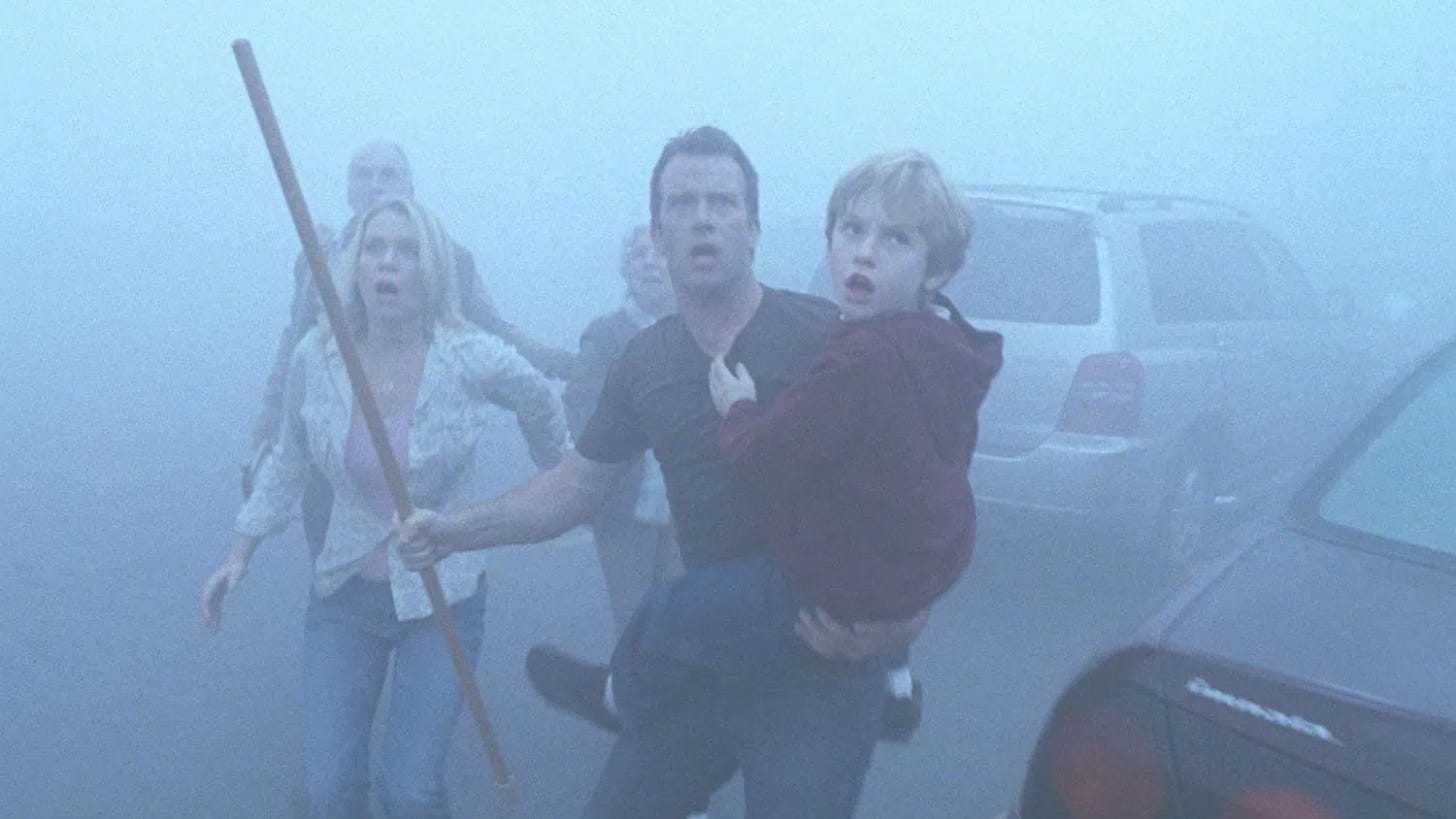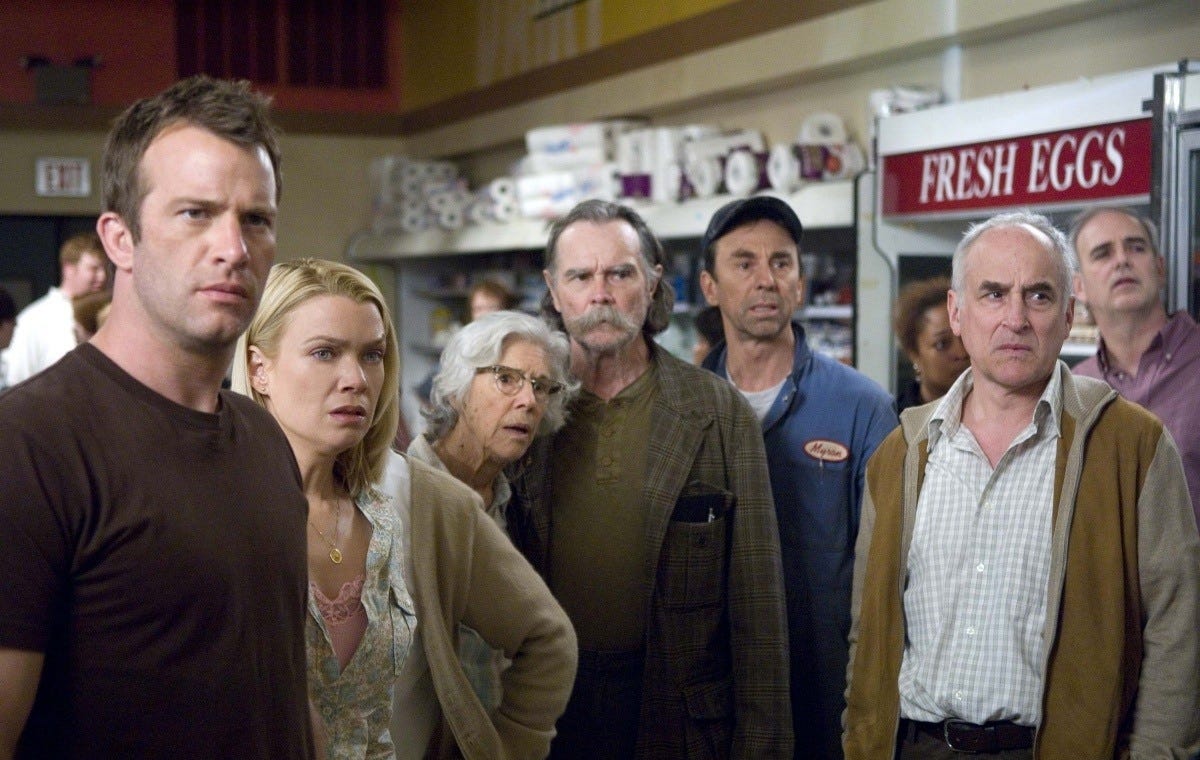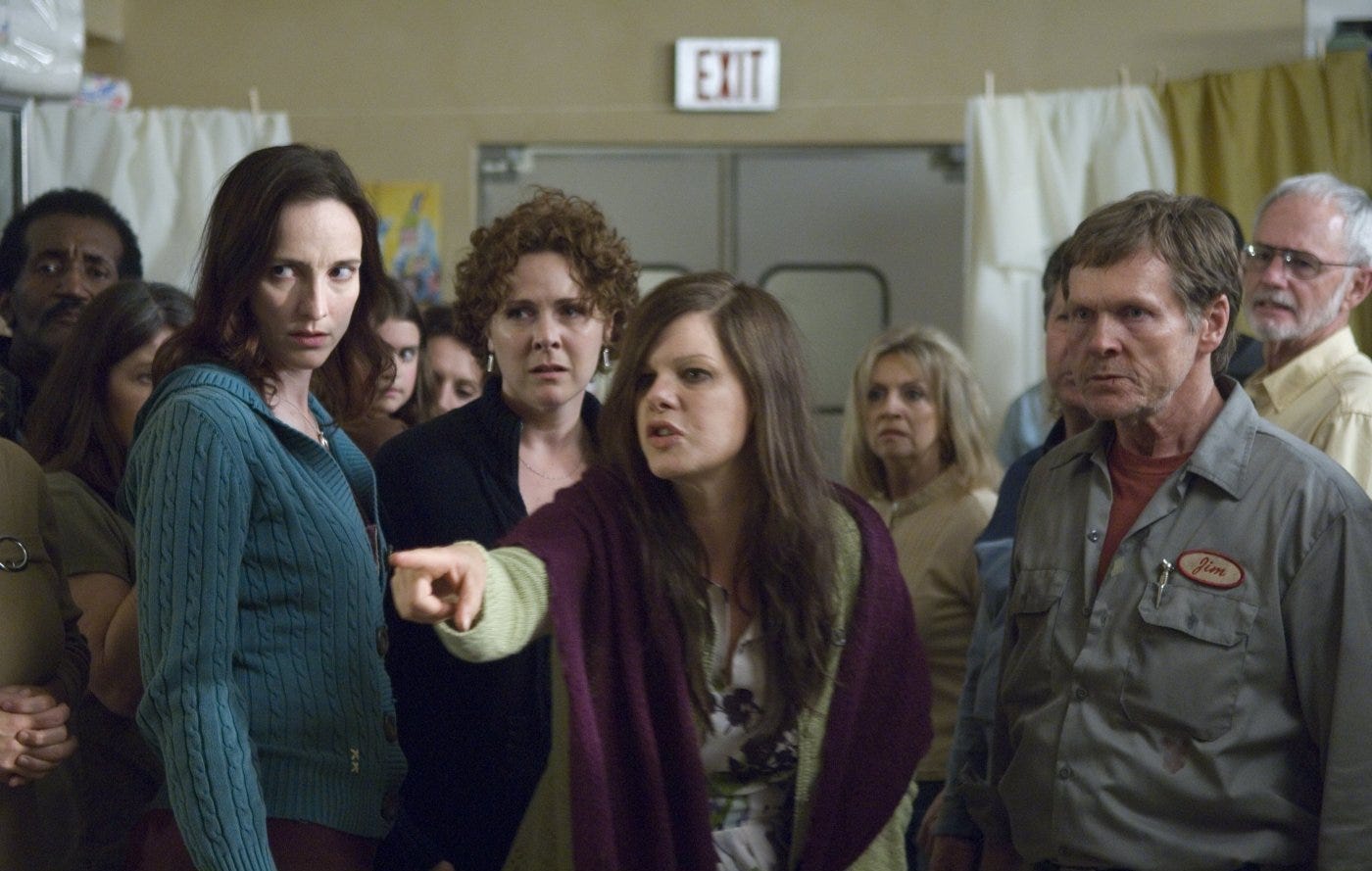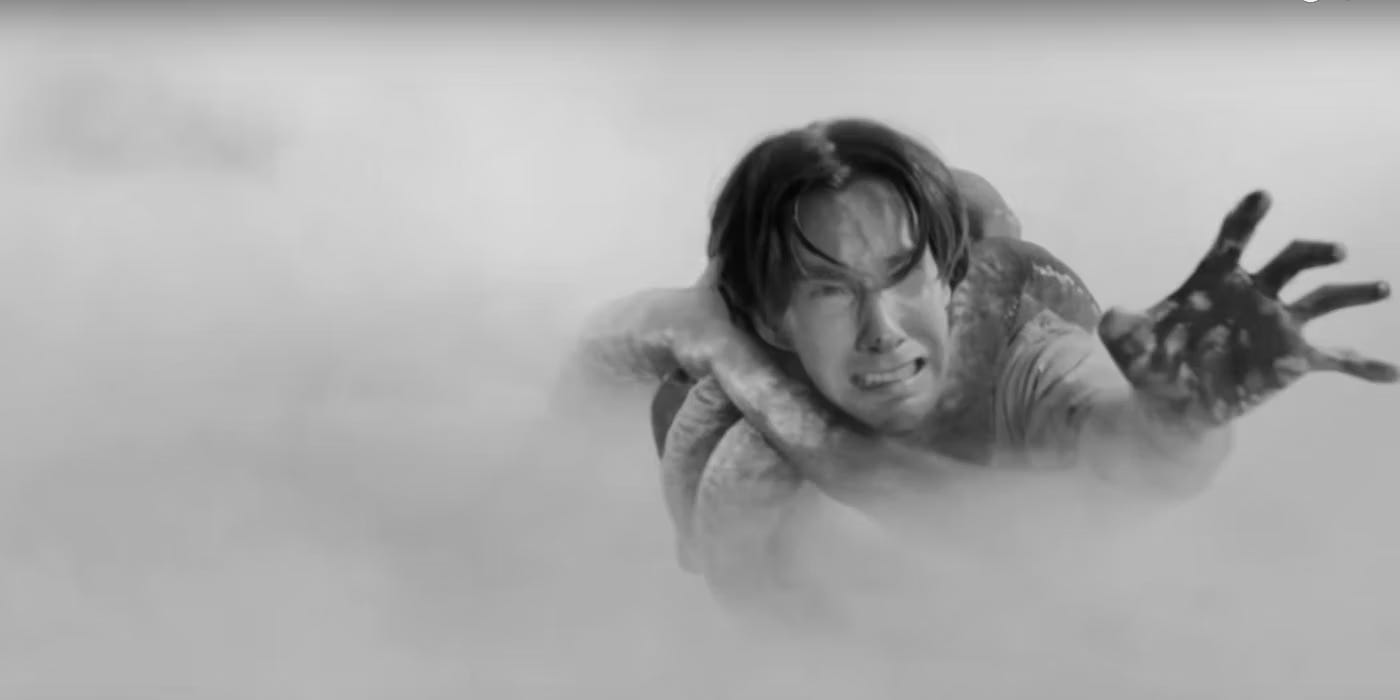'The Mist' is the Timeliest Horror Movie of 2023
(Even though Frank Darabont's Stephen King adaptation was released in 2007.)
Stop me if you’ve lived this one before: from out of nowhere, a vague threat spreads across America. No one really knows where it comes from or what caused it. Even its nature is unclear. What is clear is it kills all those who come into contact with it. Unless it doesn’t. There’s a lot about the threat those who face it don’t understand. This confusion allows room for misinformation. The misinformation opens up opportunities, giving confidence and fervor to those who would have been dismissed as crazy in the times before the threat arrived—even hours before the threat arrived—and making them look like prophets worth following. Factions develop. The imperiled turn on one another, only deepening the danger. Pragmatism gets drowned in dogmatism and bile. Hope fades as a new, bleak reality emerges.
This is, of course, the plot of The Mist, a horror movie directly inspired by the COVID-19 pandemic and the madness that accompanied it. Or at least that’s how it feels watching The Mist in 2023. In actuality, the film arrived in theaters on Thanksgiving weekend in 2007 (perhaps not the ideal moment to launch a deeply pessimistic horror movie*). Yet while it’s tempting to declare The Mist ahead of its time, its timelessness may be its scariest aspect.
Director Frank Darabont began his film career in earnest by adapting Stephen King with his 1983 short film “The Woman in the Room,” and he maintained the habit with three of the four features he directed. But where The Shawshank Redemption and The Green Mile explored a gentler side of King—if films with brutal prison assaults and executions can be called “gentle”—The Mist taps into a more despairing vein of King’s work, even before it arrives at a darker ending than the one found in King’s 1980 novella.
Set, like its source, in Bridgton, Maine, the film opens as an unseasonably powerful storm rolls in off the lake where David Drayton (Thomas Jane) makes his home with his wife Stephanie (Kelly Collins Lintz) and son Billy (Nathan Gamble). A painter of movie posters modeled after Drew Struzan (whose artwork can be seen in David’s studio and who created an unused poster for The Mist), David spends the morning after the storm assessing the damage and discussing a fallen tree with his neighbor Brent (Andre Braugher), a big-city attorney who summers in the house next door. A past property dispute has made relations between David and Brent frosty, but the frost begins to thaw a bit when David offers his suddenly car-less neighbor a ride into town to pick up supplies.
Once there, they find a bunch of townspeople lined up with full grocery carts, preparing for the worst, or what they imagine the worst could be. What they don’t anticipate is a thick cloud rolling in, engulfing the parking lot, and just ahead of it a man soon revealed to be named Dan (Jeffrey De Munn) with a warning: “There’s something in the mist.”
The Mist eventually reveals what that “something” is, but it’s never more suspenseful than in the moments before answering that question. (And here’s where the spoiler-averse should bookmark this page and come back after watching the film.) But even after unveiling that the impenetrable clouds hide everything from swarms of deadly insect-like creatures to Lovecraftian monsters of madness-inducing form and scale, it’s the boggled panic their presence induces that’s the movie’s real focus, and the source of its deepest horror.
Clinging to how he understood the world to work before the arrival of the mist, even after bearing witness to evidence of one of its monsters, Brent tries to reason his way out of their predicament. This can’t be happening, ergo it is not happening, ergo he and a handful of similarly rational-minded can simply walk into the parking lot and drive off. It’s one of the film’s most unnerving touches that we never definitively learn what becomes of them after they leave. Another shopper exiting at the same time meets a gruesome fate. But Brent and the others? Who can say for sure?
Another shopper, Mrs. Carmody (Marcia Gay Harden), opts for the opposite tack. A fundamentalist Christian fanatic before the arrival of the mist, she seizes the moment to preach apocalypse and rapture, using the monsters outside as proof of the wrathful God to which she prays. It’s crazy talk, or at least would be under other circumstances. But as the crisis drags on, she begins to win a flock to her side.
The Mist is not a subtle movie and Harden’s performance is one of its least-subtle elements. But what might have seemed like an attempt to exaggerate for effect 16 years ago doesn’t look so far-fetched anymore. (I’ve always liked Harden’s work here. It’s a skillfully executed exercise in going big. She knows she has to compete with giant bugs.) We live in a moment when people, and not just a few, honestly believe that satanic celebrities are killing children and harvesting their adrenochrome.
Still, though The Mist seems weirdly in sync with our current climate, it didn’t seem particularly out of sync with the atmosphere of 2007. America was deep into the second term of George W. Bush, a president who took full advantage of the Republican Party’s hold on evangelical Christians, and seems to have thought of himself as part of God’s plan. Nor did the King novella feel out of place in 1980, when it was written partly in response to the rise of the religious right. Even beyond that religious element, the film draws on themes found in the inspirations Darabont has cited, like Lord of the Flies and The Twilight Zone’s “The Monsters Are Due on Maple Street,” both unflattering depictions of mob mentality and how humans behave in crisis.**
“What's scary to me is all it takes is one massive solar flare that comes directly at us instead of off into some other direction of space, and totally knocks out our technology and puts us back into the Dark Ages,” Darabont told /Film’s Eric Vespe in an extensive oral history published last year. “If that happens, we're not going to be having a conversation like this on [the internet]. We’re going to be out there shooting deer for our dinner and trying to grow turnips in the backyard.”
But Darabont steered The Mist’s hero to an even darker fate than turnip farming, darker even than the conclusion of King’s story. After escaping from the parking lot, David, Billy, and three other survivors take a long tour of a New England laid waste by the mist, including a stop at David’s house, where he learns Stephanie has not survived. The mist and its creatures seem both inescapable and permanent, visitors from another dimension with no regard for how ours works. With seemingly nowhere else left to go, both the film and David settle on an audaciously unhappy ending—and after it, a final bit of irony to compound the tragedy.
It’s tempting to call The Mist a morality tale, but there’s not really a moral to take away. The mist’s arrival is unpredictable and unpreventable (at least by the characters we meet; the film does offer an explanation of its origins). Virtue goes unrewarded. Even those who keep their head and extend compassion to others meet unhappy fates. It could be a cautionary tale, but the only thing it clearly cautions against is being human and living amidst other humans. Ultimately, it’s a jolt of clear-eyed pessimism in horror movie form. It’s filled with tentacle-flapping, clawing, biting beasts. Yet while The Mist’s subject is monsters, they’re not of that kind.
The Mist is currently streaming on Peacock and available to rent on most other services. It was also recently released in a new 4K / Blu-ray edition containing both the color and black-and-white versions of the film.
* The film opened in 9th place at the U.S. box office, well below Enchanted and barely above Mr. Magorium’s Wonder Emporium in its fifth week in release. Nonetheless, it ended up performing respectably by the end of its run.
** In keeping true to his inspirations, which include Ray Harryhausen’s early films, Darabont created a black-and-white version of the film he prefers. As much as I love black-and-white photography, I don’t really agree. Like other color films converted to black-and-white, its compositions never really look like they were created for black-and-white. Still, it’s a neat novelty.








Terrific write-up, Keith--I just finished rereading Under the Dome, and was thinking how that book has _also_ aged unsettlingly well. This is still one of the best King adaptations for me; seeing Darabont's usual sentimentality inverted is bracingly nasty, and I love how fully it commits to its over-the-topness. (Harden's performance is great, and I like Thomas Jane a lot too; he's got this nervy, awkward energy that makes the character more than just a cipher, and the awkwardness of it feels more and more appropriate as the situation gets worse.) Horror movies often have ordinary people fighting against forces they can't begin to understand, but this one of the few ones where every choice those people make just makes things that much worse. It's like Murphy's Law as a horror movie, with all the things we've come to take for granted swept away.
SPOILERs:
I'll admit to still being iffy on the ending, if only because it feels like it crosses the line between "horrific cruelty" and into "judging cruelty." The shot of Melissa McBride, alive and well after leaving the store earlier to save her kids (and yelling at everyone who refused to go with her), is just a little too pointed, as though Jane failed some kind of hellish morality test (Jigsaw: "You've spent your life trying to protect your child from harm. Now you've protected him so hard you shot him in the head.") It's a more fitting ending to this version of the story than King's more open-ended, hopeful one, at least.
This is why I love The Reveal: How else to find the gold amid the streaming dross?